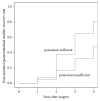Association between Blood Potassium Level and Recovery of Postoperative Gastrointestinal Motility during Continuous Renal Replacement Therapy in Patient Undergoing Open Abdominal Surgery
- PMID: 31355273
- PMCID: PMC6634123
- DOI: 10.1155/2019/6392751
Association between Blood Potassium Level and Recovery of Postoperative Gastrointestinal Motility during Continuous Renal Replacement Therapy in Patient Undergoing Open Abdominal Surgery
Abstract
Background: The aim of this study was to identify the blood potassium level beneficial to the postoperative recovery of gastrointestinal motility during continuous renal replacement therapy (CRRT) in patient undergoing open abdominal surgery.
Materials and methods: 538 critically ill patients after open abdominal surgery and receiving CRRT were retrospectively recruited as the study cohort. Demographic and clinical data were recorded along with an evaluation of the postoperative gastrointestinal motility.
Results: Correlation analysis was used to assess the correlation coefficient, and then the variables with correlation coefficient value less than 0.5 were included in the binary logistic regression model. Binary logistic regression model indicated that the postoperative blood potassium level was independently associated with the recovery of gastrointestinal motility (OR=0.109, 95% CI= 0.063 to 0.190, p<0.001). Based on the normal range of blood potassium level, we selected the cut-off point of blood potassium level via Weight of Evidence analysis, which was 4.00 mmol/L. Compared with the patients with insufficient blood potassium levels (plasma potassium concentration < 4.00 mmol/L), those with sufficient blood potassium levels (plasma potassium concentration≥ 4.00 mmol/L) conferred an increase in the rate of 4-day postoperative recovery of gastrointestinal motility (OR= 4.425, 95% CI = 2.933 to 6.667, p<0.001).
Conclusions: Maintaining the blood potassium concentrations at a relatively high level of the normal blood potassium range during CRRT would be beneficial to postoperative recovery of gastrointestinal motility.
Figures



Similar articles
-
[Analysis of the causes of arrhythmia induced by citrate anticoagulation in continuous renal replacement therapy].Zhonghua Wei Zhong Bing Ji Jiu Yi Xue. 2021 Jun;33(6):748-751. doi: 10.3760/cma.j.cn121430-20210203-00197. Zhonghua Wei Zhong Bing Ji Jiu Yi Xue. 2021. PMID: 34296699 Chinese.
-
The Prognostic Importance of Serum Sodium for Mortality among Critically Ill Patients Requiring Continuous Renal Replacement Therapy.Nephron. 2022;146(2):153-159. doi: 10.1159/000519686. Epub 2021 Nov 18. Nephron. 2022. PMID: 34794149
-
A Scoring Model with Simple Clinical Parameters to Predict Successful Discontinuation of Continuous Renal Replacement Therapy.Blood Purif. 2021;50(6):779-789. doi: 10.1159/000512350. Epub 2021 Mar 18. Blood Purif. 2021. PMID: 33735858
-
Predictors of short-term successful discontinuation of continuous renal replacement therapy: results from a prospective multicentre study.BMC Nephrol. 2019 Apr 15;20(1):129. doi: 10.1186/s12882-019-1327-9. BMC Nephrol. 2019. PMID: 30987604 Free PMC article.
-
Association of Phosphate Containing Solutions with Incident Hypophosphatemia in Critically Ill Patients Requiring Continuous Renal Replacement Therapy.Blood Purif. 2022;51(2):122-129. doi: 10.1159/000514418. Epub 2021 Apr 29. Blood Purif. 2022. PMID: 33915554
Cited by
-
Risk Factors Asscociated with Hypokalemia during Postanesthesia Recovery and Its Impact on Outcomes in Gynecological Patients: A Propensity Score Matching Study.Curr Med Sci. 2024 Apr;44(2):441-449. doi: 10.1007/s11596-024-2848-4. Epub 2024 Apr 2. Curr Med Sci. 2024. PMID: 38561592
-
Exploring perioperative risk factors for poor recovery of postoperative gastrointestinal function following gynecological surgery: A retrospective cohort study.Heliyon. 2023 Dec 15;10(1):e23706. doi: 10.1016/j.heliyon.2023.e23706. eCollection 2024 Jan 15. Heliyon. 2023. PMID: 38205292 Free PMC article.
References
-
- Lobo D. N., Bostock K. A., Neal K. R., Perkins A. C., Rowlands B. J., Allison S. P. Effect of salt and water balance on recovery of gastrointestinal function after elective colonic resection: a randomised controlled trial. The Lancet. 2002;359(9320):1812–1818. doi: 10.1016/S0140-6736(02)08711-1. - DOI - PubMed
-
- González-Fajardo J., Mengibar L., Brizuela J., Castrodeza J., Vaquero-Puerta C. Effect of postoperative restrictive fluid therapy in the recovery of patients with abdominal vascular surgery. European Journal of Vascular and Endovascular Surgery. 2009;37(5):538–543. doi: 10.1016/j.ejvs.2009.01.010. - DOI - PubMed
Publication types
MeSH terms
Substances
LinkOut - more resources
Full Text Sources
Medical

